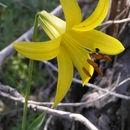en
names in breadcrumbs


Plants from the San Gabriel Mountains of California sometimes have wider leaves and have been given status as Lilium parryi var. kessleri, but this variation is due primarily to the rather shaded habitat of many of these populations. No significant vegetative discontinuity can be recognized across the range of this species, so no varieties are recognized here. Lilium parryi probably arose from an ancestor in common with L. pardalinum (M. W. Skinner 1988), and subsequently diverged to become pollinated by various hawkmoths (family Sphingidae). The flowers are remarkably similar in form and function to those of L. washingtonianum, which is also moth-pollinated, but this resemblance is due to evolutionary convergence.
Lilium parryi, common name lemon lily, is a rare species of lily.[3][4][5]
Lilium parryi is native to the southwestern United States and northwestern Mexico where it grows in moist areas in mountain habitats. In California it is currently known from the San Bernardino and San Gabriel Mountains and a few remaining spots near Palomar Mountain to the south.[6] It is the only true lily native to Arizona, where a few populations can be found in the Huachuca, Chiricahua, and Santa Rita Mountains.[7] In Mexico, it has been found in mountains in the states of Sonora and Baja California.[2][6][8][9][10]
Lilium parryi is a perennial herb growing erect to about 2 meters in height from a scaly, elongated bulb up to 11 centimetres (4+1⁄3 in) long. The leaves are generally linear in shape, up to 29 centimetres (11+1⁄2 in) long, and usually arranged in whorls around the stem. The inflorescence is a raceme bearing up to 31 large, showy, bright lemon yellow flowers. The trumpet-shaped, fragrant flowers have six curling tepals up to 11 centimetres (4+1⁄3 in) long, sometimes with a few reddish spots. There are six stamens tipped with large anthers up to 1.4 centimetres (1⁄2 in) long. The pistil may be 10 centimetres (4 in) long. The flowers are pollinated by hawkmoths,[11] especially Hyles lineata and Sphinx perelegans.[12]
Threats to this species include grazing, recreation, natural flooding and human alterations in water regimes, and horticultural collecting of the bulbs and flowers.
Lilium parryi was named for Charles Christopher Parry (28 August 1823 – 20 February 1890), a British-American botanist and mountaineer.
Idyllwild, California, hosts the Lemon Lily Festival, which celebrates this species.[13]
Lilium parryi, common name lemon lily, is a rare species of lily.
Lilium parryi is native to the southwestern United States and northwestern Mexico where it grows in moist areas in mountain habitats. In California it is currently known from the San Bernardino and San Gabriel Mountains and a few remaining spots near Palomar Mountain to the south. It is the only true lily native to Arizona, where a few populations can be found in the Huachuca, Chiricahua, and Santa Rita Mountains. In Mexico, it has been found in mountains in the states of Sonora and Baja California.
Lilium parryi is a perennial herb growing erect to about 2 meters in height from a scaly, elongated bulb up to 11 centimetres (4+1⁄3 in) long. The leaves are generally linear in shape, up to 29 centimetres (11+1⁄2 in) long, and usually arranged in whorls around the stem. The inflorescence is a raceme bearing up to 31 large, showy, bright lemon yellow flowers. The trumpet-shaped, fragrant flowers have six curling tepals up to 11 centimetres (4+1⁄3 in) long, sometimes with a few reddish spots. There are six stamens tipped with large anthers up to 1.4 centimetres (1⁄2 in) long. The pistil may be 10 centimetres (4 in) long. The flowers are pollinated by hawkmoths, especially Hyles lineata and Sphinx perelegans.
Threats to this species include grazing, recreation, natural flooding and human alterations in water regimes, and horticultural collecting of the bulbs and flowers.
Lilium parryi was named for Charles Christopher Parry (28 August 1823 – 20 February 1890), a British-American botanist and mountaineer.
Idyllwild, California, hosts the Lemon Lily Festival, which celebrates this species.